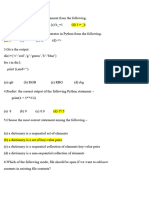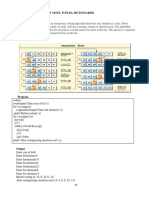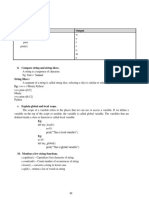Getting Started With Python Assignment PDF
Uploaded by
Nidhi BansalGetting Started With Python Assignment PDF
Uploaded by
Nidhi BansalIntroduction to Python Assignment
Problem Statement:
Consider yourself to be Sam who is a data scientist. He has been invited as a guest lecturer at a college
to take an introductory session on Python.
Tasks to be performed:
1. Create 1st tuple with values -> (10,20,30), 2nd tuple with values -> (40,50,60).
a. Concatenate the two tuples and store it in “t_combine”
b. Repeat the elements of “t_combine” 3 times
c. Access the 3rd element from “t_combine”
d. Access the first three elements from “t_combine”
e. Access the last three elements from “t_combine”
2. Create a list ‘my_list’ with these elements:
a. First element is a tuple with values 1,2,3
b. Second element is a tuple with values “a”,”b”,”c”
c. Third element is a tuple with values True,False
3. Append a new tuple – (1,’a’,True) to ‘my_list’
a. Append a new list – [“sparta”,123] to my_list
4. Create a dictionary ‘fruit’ where:
a. The first key is ‘Fruit’ and the values are (“Apple”,”Banana”,”Mango”,”Guava”)
b. The second key is ‘Cost’ and the values are (85,54,120,70)
c. Extract all the keys from ‘fruit’
d. Extract all the values from ‘fruit’
5. Crete a set named ‘my_set’ with values (1,1,”a”,”a”,True,True) and print the result
You might also like
- 5.lists: 5.1. Accessing Values in Lists ExNo ratings yet5.lists: 5.1. Accessing Values in Lists Ex8 pages
- First - Last@mycollege - Edu: Assignment #6 (2%)No ratings yetFirst - Last@mycollege - Edu: Assignment #6 (2%)2 pages
- Introduction To Python Assignment: Problem Statement0% (1)Introduction To Python Assignment: Problem Statement1 page
- Data Structures - Stack - and - Queue - Hands-On100% (1)Data Structures - Stack - and - Queue - Hands-On3 pages
- CS5800: Principles of Computation and Programming Time Allowed: Answer ALL QuestionsNo ratings yetCS5800: Principles of Computation and Programming Time Allowed: Answer ALL Questions7 pages
- Workshop #4: Inheritance: Learning OutcomesNo ratings yetWorkshop #4: Inheritance: Learning Outcomes4 pages
- Python Regular Expression - Exercises, Practice, Solution - W3resource12No ratings yetPython Regular Expression - Exercises, Practice, Solution - W3resource121 page
- MCQ Function File Handling Python ReviewNo ratings yetMCQ Function File Handling Python Review23 pages
- Topic: Evolution of Java, Java Architecture, Language Basics, Flow Control25% (4)Topic: Evolution of Java, Java Architecture, Language Basics, Flow Control15 pages
- Ain Shams University Faculty of EngineeringNo ratings yetAin Shams University Faculty of Engineering2 pages
- Lecture 3: Fields, Getters and Setters, Constructors, TestingNo ratings yetLecture 3: Fields, Getters and Setters, Constructors, Testing21 pages
- Sol PYTHON PROG - III Sem Question Paper (2023-24) OddNo ratings yetSol PYTHON PROG - III Sem Question Paper (2023-24) Odd25 pages
- Unit Iv Lists, Tuples, Dictionaries Insertion SortNo ratings yetUnit Iv Lists, Tuples, Dictionaries Insertion Sort12 pages
- Tareas para la asignatura Python 1 de la THDNo ratings yetTareas para la asignatura Python 1 de la THD20 pages































































